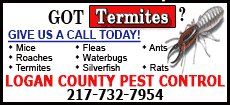|
Grub control options
By John
Fulton
 Send a link to a friend
Send a link to a friend
[August 18, 2008]
We have discussed the timing of grub control
treatments in past columns. As a reminder, the date would have been
early August for annual white grubs. We are now approaching
treatment for grubs coming from the Japanese beetles. Knowing when
to treat grubs is one thing, and knowing what product to use is
another.
|
 Many grub control treatments are combined with fertilizer
products, and this is the appropriate time to apply a fall
fertilizer treatment. It seems each year provides more
"stand-alone" treatment options as well. Diazinon used to be the
product of choice for many homeowners, but the cancellation of
home horticulture uses of the product created confusion in
selecting a product. The other wild card was that the use of
diazinon helped eliminate mole problems (by driving them to the
neighbor's yard) since the product killed grubs and reduced
earthworm populations. Many of the products currently used do
not affect earthworm populations, and on the whole that is a
good thing since earthworms greatly benefit lawns. There are now
some "soft baits" available for mole control that are effective. Many grub control treatments are combined with fertilizer
products, and this is the appropriate time to apply a fall
fertilizer treatment. It seems each year provides more
"stand-alone" treatment options as well. Diazinon used to be the
product of choice for many homeowners, but the cancellation of
home horticulture uses of the product created confusion in
selecting a product. The other wild card was that the use of
diazinon helped eliminate mole problems (by driving them to the
neighbor's yard) since the product killed grubs and reduced
earthworm populations. Many of the products currently used do
not affect earthworm populations, and on the whole that is a
good thing since earthworms greatly benefit lawns. There are now
some "soft baits" available for mole control that are effective.

Current recommended products include halofenozide (Mach 2),
Heterorhabditis bacteriophora (Cruiser), imidacloprid (Merit)
and trichlorfon (Dylox). Many of the chemicals have other brand
names in addition to the ones listed in parenthesis. It is also
recommended to drench treated areas with a half-inch of water
within 30 minutes of application, and this is especially
important with liquid applications. Application just ahead of a
rain is usually best. Granular applications buy a few days of
time but still need to be watered into the root zone where grubs
are active. The products with Merit will take three weeks or so
to activate. Some reputable sources also list carbaryl (Sevin)
granules as an option for grubs from green June bugs and
Japanese beetles. Carbaryl does reduce earthworm populations to
some degree.
In good growing seasons, it normally takes at least 10 grubs
per square foot of lawn area to justify treatment. In less
favorable seasons, this number can be reduced to six to eight
grubs per square foot. As your gasoline bill for the lawn mower
can attest, this has been a good growing season to date.
[to top of second column]
 |

Consider many factors when selecting a product. These would include
combination with fertilizer, effectiveness, species controlled, cost
and the effect on the environment. The Cruiser product is actually a
nematode and would be the most environmentally safe. It also costs
about $55 to treat about 3,000 square foot of lawn. The other
organic product sometimes mentioned for control of the Japanese
beetle grubs is milky spore. This product is a bacteria that takes
several years to become very effective and can cost around $35 for
2,500 square feet of lawn. You can't apply any other controls with
milky spore since you need high populations of grubs to increase the
bacteria populations to high levels and provide transmission between
grubs.
Good luck as you decide your attack plans against grubs. The
choices are many, and the attainment of the "perfect" lawn is a goal
many strive for. Remember, you can live with some grubs. However,
too many can be devastating to a lawn. With Japanese beetle
populations at very high levels in many areas, odds are great there
will be grubs to battle.
[By
JOHN FULTON,
University of Illinois Extension, Logan County]


 |